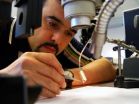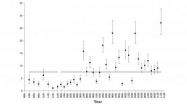(Press-News.org) A new wireless device to help victims of spinal cord injury is receiving attention in the research community. Mesut Sahin, PhD, associate professor, in the department of biomedical engineering at NJIT, recently has published and presented news of his findings to develop micro-electrical stimulators for individuals with spinal cord injuries.
The work, now in its third year of support from a four-year, $1.4 million National Institutes of Health (NIH) grant, has resulted in the development and testing of a technology known by its acronym, FLAMES (floating light activated micro-electrical stimulators). The technology, really a tiny semiconductor device, will eventually enable people with spinal cord injuries to restore some of the motor functions that are lost due to injury. Energized by an infrared light beam through an optical fiber located just outside the spinal cord these micro-stimulators will activate the nerves in the spinal cord below the point of injury and thus allow the use of the muscles that were once paralyzed.
This past September, The Journal of Neural Engineering ("FLAMES tested in the rat spinal cord," http://iopscience.iop.org/1741-2552/8/5/056012) published the first testing in animals. "Our in vivo tests suggest that the FLAMES can be used for intraspinal micro-stimulation even for the deepest implant locations in the rat spinal cord," said Sahin.
"The power required to generate a threshold arm movement was investigated as the laser source was moved away from the micro-stimulator. The results indicate that the photon density does not decrease substantially for horizontal displacements of the source that are in the same order as the beam radius. This gives confidence that the stimulation threshold may not be very sensitive to small displacement of the spinal cord relative to the spine-mounted optical power source." Sahin spoke about this work at the IEEE Engineering in Medicine and Biology Conference in Boston, also in September of 2011.
FLAMES is a semiconductor device that is remotely controlled by an optical fiber attached to a low power near-infrared laser. The device is implanted into the spinal cord, and is then allowed to float in the tissue. There are no attached wires. A patient pushes a button on the external unit to activate the laser, the laser then activates the FLAMES device.
"The unique aspect of the project is that the implanted stimulators are very small, in the sub-millimeter range," Sahin said. "A key benefit is that since our device is wireless, the connections can't deteriorate over time plus, the implant causes minimal reaction in the tissue which is a common problem with similar wired devices."
The electrical activation of the central and peripheral nervous system has been investigated for treatment of neural disorders for many decades and a number of devices have already successfully moved into the clinical phase, such as cochlear implants and pain management via spinal cord stimulation. Others are on the way, such as micro stimulation of the spinal cord to restore locomotion, micro stimulation of the cochlear nucleus, midbrain, or auditory cortex to better restore hearing and stimulation of the visual cortex in the blind subject. All of them, however, are wired, unlike FLAMES, which is not.
Selim Unlu, professor of electrical and computer engineering at Boston University, is working with Sahin. "We hope that once FLAMES advances to the clinical stage, patients paralyzed by spinal injury will be able to regain vital functions," Sahin said.
INFORMATION:
NJIT, New Jersey's science and technology university, enrolls more than 9,558 students pursuing bachelor's, master's and doctoral degrees in 120 programs. The university consists of six colleges: Newark College of Engineering, College of Architecture and Design, College of Science and Liberal Arts, School of Management, College of Computing Sciences and Albert Dorman Honors College. U.S. News & World Report's 2010 Annual Guide to America's Best Colleges ranked NJIT in the top tier of national research universities. NJIT is internationally recognized for being at the edge in knowledge in architecture, applied mathematics, wireless communications and networking, solar physics, advanced engineered particulate materials, nanotechnology, neural engineering and e-learning. Many courses and certificate programs, as well as graduate degrees, are available online through the Office of Continuing Professional Education.
NJIT researcher testing micro-electronic stimulators for spinal cord injuries
2011-10-19
ELSE PRESS RELEASES FROM THIS DATE:
Palm Harbor Dentist Celebrates 25 Years in Dentistry
2011-10-19
As the leaves begin to change colors for the fall, Dr. Kevin Kiley, Palm Harbor dentist, celebrates 25 years in dentistry. During the month of October, Dr. Kevin Kiley's staff encourages patients to celebrate Dr. Kiley's 25th year in dentistry in North Pinellas County.
"It is a privilege to be celebrating 25 years in dentistry. I am honored to continue to serve my patients and I look forward to many more years of making my patients smile bigger and brighter," said Dr. Kevin Kiley, dentist in Palm Harbor, FL.
Dr. Kevin Kiley graduated from Northwestern ...
50 years of cereal leaf beetle management research
2011-10-19
A new, open-access article in the Journal of Integrated Pest Management provides a review of cereal leaf beetle biology, past and present management practices, and current research being conducted.
Cereal leaf beetle, Oulema melanopus L., is an introduced insect pest of small grains first recorded in the United States in the early 1960s. Since its introduction from Europe or Asia into Michigan, cereal leaf beetle has rapidly spread and can now be found in most states. Cereal leaf beetle feeds on numerous species of grasses and is considered a major pest of oats, barley, ...
Pecan ipmPIPE: Harnessing the Internet for stakeholders in production agriculture
2011-10-19
A new, open-access article (http://tinyurl.com/5voksnc) in the Journal of Integrated Pest Management examines the Pecan Pest Information Platform for Extension and education (PIPE), a program that provides a new informatics resource that targets 5,000 pecan stakeholders located primarily in the southern tier of the United States.
Pecan scientists and producers working with information technology experts have developed and delivered this program via the Internet since 2009. Stakeholder participation in and adoption of this resource has grown since inception and is expected ...
Toms River Cosmetic Dentist Offers Brighter, Whiter Smiles for Life
2011-10-19
Leading Toms River cosmetic dentist, Dr. Stan Mahan, is pleased to offer new patients free whitening for life when scheduling an appointment. All new patients can now receive free whitening for life when they schedule a new patient exam with full mouth x-ray and prophy.
When new patients make their appointment with Dr. Stan Mahan, emergency dentist in Toms River, they can mention the online coupon to receive their free whitening for life. This special is not to be combined with any other coupon.
"I want my patients to smile longer and brighter than they have ...
New provincial atlas; information on lab testing key to managing diabetes among Albertans
2011-10-19
Edmonton, AB - A report just released by the Alberta Diabetes Surveillance System (ADSS) shows a need for more teamwork among patients and their health-care providers and more effective use of medical records to aid Albertans with getting the laboratory tests necessary to help manage and prevent long-term complications of the disease.
This is the first time that the Alberta Diabetes Atlas has included additional sources of data. With this enhancement it has become a vital tool for front line health-care providers and policy makers.
According to the Atlas, many Albertans ...
Researchers find possible link between bacterium and colon cancer
2011-10-19
BOSTON¬—Scientists at Dana-Farber Cancer Institute and the Broad Institute have found strikingly high levels of a bacterium in colorectal cancers, a sign that it might contribute to the disease and potentially be a key to diagnosing, preventing, and treating it.
In a study published online in the journal Genome Research, investigators report the discovery of an abnormally large number of Fusobacterium cells in nine colorectal tumor samples. While the spike does not necessarily mean the bacterium helps cause colorectal cancer, it offers an enticing lead for further research, ...
Pasadena Cosmetic Dentist Adds New Features to Social Media Sites - Facebook and Twitter
2011-10-19
Dr. H. Robert Stender, Pasadena cosmetic dentist, is pleased to announce the recent addition of informative articles and testimonials of his practice to Facebook and Twitter. Patients are encouraged to become fans of Dr. Stender's Facebook and to "follow" him on Twitter, as well, for frequent updates.
"Facebook and Twitter are quickly becoming more popular as technology quickly advances. A majority of my patients actively utilize the benefits of the Internet through social media sites, making the decision to launch my own a necessity. With the launch of ...
Research examines approaches to treating substance abuse among African-Americans
2011-10-19
A new study is the first to examine the effectiveness of a widely used counseling approach to treating substance abuse among African-Americans. The study found that African-American women were more likely than men to continue a counseling approach to treating substance abuse, but their substance-abuse issues continued. The study led by LaTrice Montgomery, a doctoral student in the University of Cincinnati Department of Psychology, is published this month in "Cultural Diversity and Ethnic Minority Psychology," a journal of the American Psychological Association.
The study ...
Links in the chain: Global carbon emissions and consumption
2011-10-19
Washington, D.C. — It is difficult to measure accurately each nation's contribution of carbon dioxide to the Earth's atmosphere. Carbon is extracted out of the ground as coal, gas, and oil, and these fuels are often exported to other countries where they are burned to generate the energy that is used to make products. In turn, these products may be traded to still other countries where they are consumed. A team led by Carnegie's Steven Davis, and including Ken Caldeira, tracked and quantified this supply chain of global carbon dioxide emissions. Their work will be published ...
2011 a banner year for young striped bass in Virginia
2011-10-19
Preliminary results from a 2011 survey conducted by researchers at the Virginia Institute of Marine Science (VIMS) suggest the production of a strong class of young-of-year striped bass in the Virginia portion of Chesapeake Bay. The 2011 year class represents the group of fish hatched this spring.
The results are good news for the recreational and commercial anglers who pursue this popular game fish because this year class is expected to grow to fishable size in 3 to 4 years. The results are also good news for Chesapeake Bay, where striped bass play an important ecological ...



